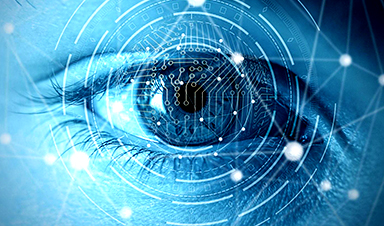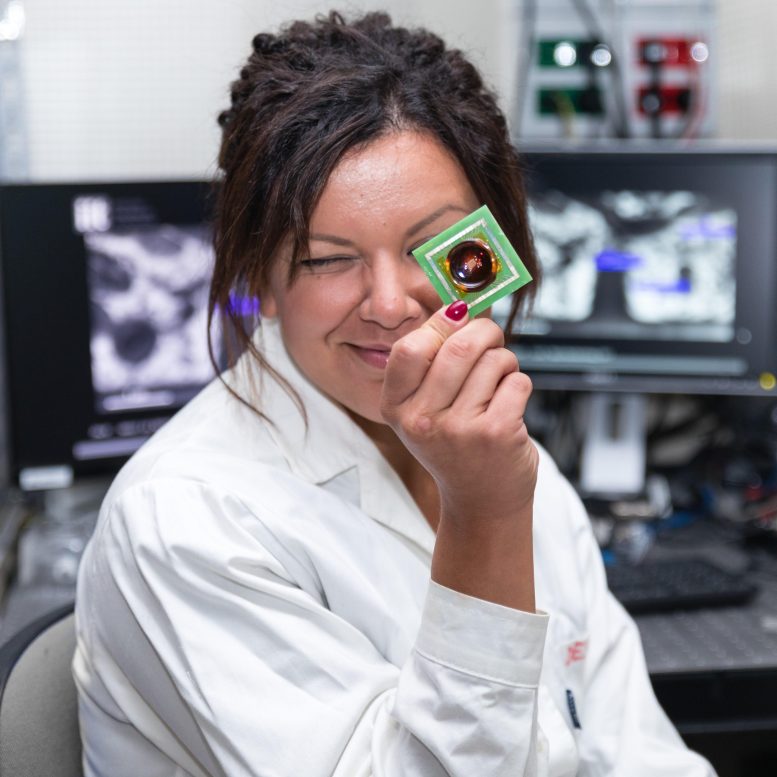A team of international researchers, led by Francesca Santoro from Jülich, has developed a biochip that imitates the human retina. This innovation is part of a broader effort in bioelectronics aimed at repairing bodily and brain dysfunctions. The creation of this chip is a collaborative achievement involving experts from Forschungszentrum Jülich, RWTH Aachen University, Istituto Italiano di Tecnologia, and the University of Naples. Their work and findings have been published in the journal Nature Communications.
The fusion of man and machine is the epitome of a science fiction narrative. In real life, the first steps towards such cyborgs have long been taken: people have pacemakers to treat arrhythmias or cochlear implants to improve hearing, and retinal implants help people who are almost blind to see at least a little. A new chip could help retinal implants fuse even better with the human body in the future. It is based on conductive polymers and light-sensitive molecules that can be used to imitate the retina, complete with visual pathways. It was developed by Francesca Santoro’s research group at Jülich’s Institute for Bioelectronics (IBI-3) in collaboration with RWTH Aachen University, the Istituto Italiano di Tecnologia in Genoa and the University of Naples.
“Our organic semiconductor recognizes how much light falls on it. Something similar happens in our eyes. The amount of light that hits the individual photoreceptors ultimately creates the image in the brain,” explains Santoro, who is Professor of Neuroelectronic Interfaces at RWTH Aachen University and also a visiting researcher at the Istituto Italiano di Tecnologia.
Versatile chip
What is exceptional about the new semiconductor is that it consists entirely of non-toxic organic components, is flexible, and works with ions, that is, with charged atoms or molecules. It can thus be integrated into biological systems much better than conventional semiconductor components made of silicon, which are rigid and only work with electrons. “Our body cells specifically use ions to control certain processes and exchange information,” explains the researcher. However, the development is, so far, only a “proof-of-concept”, she emphasizes. The material was synthesized and then characterized: “We were able to show that the typical properties of the retina can be imitated with it,” she says.
The researchers are already thinking about another possible application: the chip could also function as an artificial synapse as light irradiation changes the conductivity of the polymer that is used in the short and long term. Real synapses work in a similar way: by passing on electrical signals, they change their size and efficiency, for example, which is the basis for our brain’s learning and memory capacity. Santoro is looking ahead: “In future experiments, we want to couple the components with biological cells and connect many individual ones together.”
Understanding neurons
In addition to the artificial retina, Santoro’s team is developing other approaches for bioelectronic chips that can interact in a similar way with the human body, specifically the cells of the nervous system. “On the one hand, we are trying to replicate the three-dimensional structure of nerve cells and, on the other hand, we are also trying to replicate their functions, for example, processing and storing information.”
The biopolymers they used in the artificial retina proved to be a suitable starting material for this. “We can use them to reproduce the branched structure of human nerve cells with their many dendrites. You can imagine it a bit like a tree,” the scientist explains. This is important because real cells prefer such branched three-dimensional structures to smooth surfaces and thus establish close contacts with the artificial ones.
Firstly, the different biochips can be used to study real neurons – for example, the cellular exchange of information. Secondly, Santoro and her team hope that someday they will be able to use their components to actively intervene in the communication pathways of the cells in order to trigger certain effects. For example, Santoro is thinking here of correcting errors in the processing and transmission of information that occur in neurodegenerative diseases such as Parkinson’s or Alzheimer’s disease, or of supporting organs that no longer function properly. In addition, such components could also serve as an interface between artificial limbs or joints.
Computer technology could benefit as well. Due to their properties, the chips are predestined to serve as hardware for artificial neural networks. So far, AI programs are still working with classical processors that cannot adapt their structure. They merely imitate the self-learning operating principle of changing neural networks by means of sophisticated software. This is very inefficient. Artificial neurons could remedy this previous deficiency: “They would enable computer technology that imitates the way the brain works at all levels,” says Santoro.
Reference: “Azobenzene-based optoelectronic transistors for neurohybrid building blocks” by Federica Corrado, Ugo Bruno, Mirko Prato, Antonio Carella, Valeria Criscuolo, Arianna Massaro, Michele Pavone, Ana B. Muñoz-García, Stiven Forti, Camilla Coletti, Ottavia Bettucci and Francesca Santoro, 2 November 2023, Nature Communications.
DOI: 10.1038/s41467-023-41083-2
News
Team finds flawed data in recent study relevant to coronavirus antiviral development
The COVID pandemic illustrated how urgently we need antiviral medications capable of treating coronavirus infections. To aid this effort, researchers quickly homed in on part of SARS-CoV-2's molecular structure known as the NiRAN domain—an [...]
Drug-Coated Neural Implants Reduce Immune Rejection
Summary: A new study shows that coating neural prosthetic implants with the anti-inflammatory drug dexamethasone helps reduce the body’s immune response and scar tissue formation. This strategy enhances the long-term performance and stability of electrodes [...]
Scientists discover cancer-fighting bacteria that ‘soak up’ forever chemicals in the body
A family of healthy bacteria may help 'soak up' toxic forever chemicals in the body, warding off their cancerous effects. Forever chemicals, also known as PFAS (per- and polyfluoroalkyl substances), are toxic chemicals that [...]
Johns Hopkins Researchers Uncover a New Way To Kill Cancer Cells
A new study reveals that blocking ribosomal RNA production rewires cancer cell behavior and could help treat genetically unstable tumors. Researchers at the Johns Hopkins Kimmel Cancer Center and the Department of Radiation Oncology and Molecular [...]
AI matches doctors in mapping lung tumors for radiation therapy
In radiation therapy, precision can save lives. Oncologists must carefully map the size and location of a tumor before delivering high-dose radiation to destroy cancer cells while sparing healthy tissue. But this process, called [...]
Scientists Finally “See” Key Protein That Controls Inflammation
Researchers used advanced microscopy to uncover important protein structures. For the first time, two important protein structures in the human body are being visualized, thanks in part to cutting-edge technology at the University of [...]
AI tool detects 9 types of dementia from a single brain scan
Mayo Clinic researchers have developed a new artificial intelligence (AI) tool that helps clinicians identify brain activity patterns linked to nine types of dementia, including Alzheimer's disease, using a single, widely available scan—a transformative [...]
Is plastic packaging putting more than just food on your plate?
New research reveals that common food packaging and utensils can shed microscopic plastics into our food, prompting urgent calls for stricter testing and updated regulations to protect public health. Beyond microplastics: The analysis intentionally [...]
Aging Spreads Through the Bloodstream
Summary: New research reveals that aging isn’t just a local cellular process—it can spread throughout the body via the bloodstream. A redox-sensitive protein called ReHMGB1, secreted by senescent cells, was found to trigger aging features [...]
AI and nanomedicine find rare biomarkers for prostrate cancer and atherosclerosis
Imagine a stadium packed with 75,000 fans, all wearing green and white jerseys—except one person in a solid green shirt. Finding that person would be tough. That's how hard it is for scientists to [...]
Are Pesticides Breeding the Next Pandemic? Experts Warn of Fungal Superbugs
Fungicides used in agriculture have been linked to an increase in resistance to antifungal drugs in both humans and animals. Fungal infections are on the rise, and two UC Davis infectious disease experts, Dr. George Thompson [...]
Scientists Crack the 500-Million-Year-Old Code That Controls Your Immune System
A collaborative team from Penn Medicine and Penn Engineering has uncovered the mathematical principles behind a 500-million-year-old protein network that determines whether foreign materials are recognized as friend or foe. How does your body [...]
Team discovers how tiny parts of cells stay organized, new insights for blocking cancer growth
A team of international researchers led by scientists at City of Hope provides the most thorough account yet of an elusive target for cancer treatment. Published in Science Advances, the study suggests a complex signaling [...]
Nanomaterials in Ophthalmology: A Review
Eye diseases are becoming more common. In 2020, over 250 million people had mild vision problems, and 295 million experienced moderate to severe ocular conditions. In response, researchers are turning to nanotechnology and nanomaterials—tools that are transforming [...]
Natural Plant Extract Removes up to 90% of Microplastics From Water
Researchers found that natural polymers derived from okra and fenugreek are highly effective at removing microplastics from water. The same sticky substances that make okra slimy and give fenugreek its gel-like texture could help [...]
Instant coffee may damage your eyes, genetic study finds
A new genetic study shows that just one extra cup of instant coffee a day could significantly increase your risk of developing dry AMD, shedding fresh light on how our daily beverage choices may [...]






















